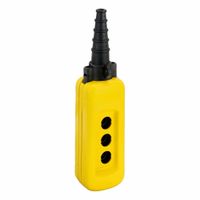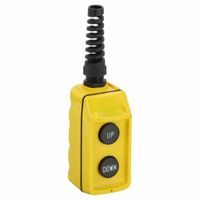Call +(254) 703 030 000 / 751 483 999 / 721 704 777
.....Read More
Frequently Asked Questions
What is a control pendant?
A control pendant, often referred to as a pendant control station or simply a pendant, is a handheld device used to operate machinery or equipment remotely. It typically features a series of buttons, switches, or joysticks that allow an operator to control various functions of a machine, such as movement, speed, and direction. Control pendants are commonly used in industrial settings, such as manufacturing plants, warehouses, and construction sites, where they provide a convenient and safe way to manage equipment like cranes, hoists, robots, and conveyor systems.
The design of a control pendant is usually ergonomic to ensure ease of use and reduce operator fatigue. It is often connected to the machinery via a cable, although wireless versions are also available. The cable or wireless connection transmits signals from the pendant to the machine's control system, enabling precise and immediate control over the equipment's operations.
Control pendants are equipped with emergency stop buttons to quickly halt operations in case of an emergency, enhancing safety. They may also include features like selector switches for different modes of operation, indicator lights to provide feedback on the machine's status, and programmable buttons for customized functions.
In robotics, a control pendant is often used for teaching purposes, allowing operators to guide a robot through specific tasks and record the movements for automated playback. This is particularly useful in applications requiring high precision and repeatability.
Overall, control pendants are essential tools in industrial automation, providing operators with the flexibility and control needed to efficiently and safely manage complex machinery and processes.
How do control pendants work?
Control pendants are handheld devices used to operate machinery remotely, typically in industrial settings. They function by sending electrical signals to the machine's control system, allowing the operator to manage various functions such as movement, speed, and direction.
The pendant is connected to the machine via a cable or wirelessly, depending on the design. It features a series of buttons, switches, or joysticks, each corresponding to a specific function of the machine. When an operator presses a button or moves a joystick, it closes an electrical circuit, sending a signal to the machine's control unit. This signal is interpreted by the machine's control system, which then executes the desired action.
Control pendants often include emergency stop buttons for safety, allowing operators to quickly halt machine operations if necessary. They may also have indicator lights or displays to provide feedback on the machine's status or operational mode.
In more advanced systems, control pendants can be programmable, allowing operators to customize functions or sequences for specific tasks. This flexibility enhances efficiency and precision in operations.
Overall, control pendants provide a convenient and safe way for operators to manage complex machinery, improving both productivity and safety in industrial environments.
What are the benefits of using a control pendant?
A control pendant, often used in industrial and manufacturing settings, offers several benefits:
1. **Enhanced Mobility**: Operators can move freely around the machinery, allowing for better visibility and access to different parts of the equipment. This mobility is crucial for tasks that require close inspection or manual adjustments.
2. **Improved Safety**: By allowing operators to control machines from a safe distance, control pendants reduce the risk of accidents. Emergency stop functions on the pendant can quickly halt operations if a hazardous situation arises.
3. **Increased Precision**: Control pendants often feature intuitive interfaces that enable precise control over machine functions. This precision is essential for tasks requiring exact positioning or adjustments.
4. **User-Friendly Interface**: Many pendants are designed with ergonomic considerations, making them comfortable to use over extended periods. The interface is typically straightforward, reducing the learning curve for new operators.
5. **Versatility**: Control pendants can be used with various types of machinery, from CNC machines to robotic arms, making them a versatile tool in different industrial applications.
6. **Real-Time Feedback**: Some pendants provide real-time data and feedback, allowing operators to monitor machine performance and make necessary adjustments on the fly.
7. **Cost-Effectiveness**: By improving operational efficiency and reducing downtime, control pendants can contribute to cost savings. They minimize the need for additional personnel to manually oversee machine operations.
8. **Customization**: Many control pendants can be customized to suit specific operational needs, with programmable buttons and functions tailored to particular tasks or machinery.
9. **Durability**: Designed for industrial environments, control pendants are typically robust and resistant to harsh conditions, ensuring longevity and reliability.
Overall, control pendants enhance operational efficiency, safety, and precision, making them an invaluable tool in modern industrial settings.
What types of control pendants are available?
Control pendants are devices used to operate machinery and equipment remotely. They come in various types, each designed for specific applications and environments:
1. **Wired Control Pendants**: These are connected to the machinery via cables. They are reliable and provide a direct connection, minimizing interference. Commonly used in industrial settings for cranes, hoists, and conveyor systems.
2. **Wireless Control Pendants**: These use radio frequency (RF) or infrared (IR) technology to communicate with machinery. They offer greater mobility and flexibility, ideal for applications where operators need to move freely.
3. **Pushbutton Pendants**: Equipped with multiple pushbuttons, these pendants allow operators to control different functions of the machinery. They are often used in simple operations like start, stop, and speed control.
4. **Joystick Pendants**: Featuring one or more joysticks, these pendants provide intuitive control for complex movements, such as those required in cranes or robotic arms.
5. **Touchscreen Pendants**: These offer a modern interface with a touchscreen display, allowing for more complex operations and real-time feedback. They are suitable for advanced machinery requiring detailed input.
6. **Explosion-Proof Pendants**: Designed for hazardous environments, these pendants are built to prevent ignition of flammable substances. They are used in industries like oil and gas, chemical processing, and mining.
7. **Ergonomic Pendants**: Focused on operator comfort, these pendants are designed to reduce strain and fatigue during prolonged use. They often feature lightweight materials and ergonomic grips.
8. **Customizable Pendants**: These allow for tailored configurations to meet specific operational needs, including custom button layouts and functions.
Each type of control pendant is selected based on the operational requirements, environmental conditions, and safety standards of the application.
How do you install a control pendant?
1. **Safety First**: Ensure all power sources are turned off to prevent electrical shock.
2. **Read the Manual**: Refer to the manufacturer's installation manual for specific instructions and safety guidelines.
3. **Select Location**: Choose an accessible location for the pendant that allows easy operation and does not obstruct movement.
4. **Mounting**: Secure the pendant's mounting bracket or support structure using appropriate hardware. Ensure it is stable and can support the pendant's weight.
5. **Cable Routing**: Route the pendant cable from the control unit to the pendant location. Use cable trays or conduits to protect the cable from damage.
6. **Connect Wiring**: Connect the pendant wires to the control unit. Follow the wiring diagram provided by the manufacturer. Ensure all connections are secure and insulated.
7. **Grounding**: Properly ground the pendant to prevent electrical hazards. Check that the grounding meets local electrical codes.
8. **Test Functionality**: Turn on the power and test the pendant's functions. Verify that all buttons and controls operate as intended.
9. **Adjust Settings**: If necessary, adjust settings such as speed or sensitivity according to operational requirements.
10. **Secure Cables**: Use cable ties or clamps to secure the pendant cable, preventing it from being pulled or damaged during operation.
11. **Labeling**: Clearly label the pendant controls for easy identification and operation.
12. **Final Inspection**: Conduct a final inspection to ensure all components are properly installed and functioning. Check for any loose connections or potential hazards.
13. **Training**: Provide training to operators on how to use the pendant safely and effectively.
14. **Documentation**: Record the installation details and any modifications made for future reference.
What industries commonly use control pendants?
Control pendants are commonly used in the following industries:
1. **Manufacturing**: Control pendants are integral in manufacturing for operating machinery such as CNC machines, assembly lines, and robotic arms. They allow operators to control and adjust machine functions safely and efficiently.
2. **Automotive**: In the automotive industry, control pendants are used for operating robotic systems in assembly lines, including welding, painting, and material handling robots.
3. **Construction**: Cranes and hoists in construction sites often use control pendants to manage lifting operations, ensuring precise control over heavy loads.
4. **Aerospace**: Control pendants are used in the aerospace industry for operating machinery involved in the production and maintenance of aircraft components, ensuring precision and safety.
5. **Warehousing and Logistics**: In warehouses, control pendants are used to operate forklifts, automated storage and retrieval systems, and conveyor belts, facilitating efficient material handling.
6. **Mining**: The mining industry uses control pendants for operating heavy machinery such as excavators, loaders, and drilling equipment, often in hazardous environments.
7. **Marine**: In the marine industry, control pendants are used for operating winches, cranes, and other equipment on ships and offshore platforms.
8. **Energy**: The energy sector, including oil and gas, uses control pendants for operating drilling rigs, cranes, and other equipment essential for exploration and production activities.
9. **Textile**: In textile manufacturing, control pendants are used to operate looms and other machinery, allowing for precise control over production processes.
10. **Food and Beverage**: Control pendants are used in food processing plants to operate packaging machines, conveyor systems, and other automated equipment.
These industries rely on control pendants for their ability to provide precise, safe, and efficient control over various types of machinery and equipment.
What safety features should be considered when using control pendants?
When using control pendants, several safety features should be considered to ensure safe and efficient operation:
1. **Emergency Stop Button**: A prominent, easily accessible emergency stop button should be included to immediately halt operations in case of an emergency.
2. **Ergonomic Design**: The pendant should be designed for comfortable use to prevent operator fatigue and reduce the risk of repetitive strain injuries.
3. **Deadman Switch**: Incorporate a deadman switch that requires constant pressure to operate, ensuring that the machine stops if the operator loses control.
4. **IP Rating**: Ensure the pendant has an appropriate Ingress Protection (IP) rating to protect against dust and water, especially in harsh environments.
5. **Cable Management**: Use durable, flexible cables with strain relief to prevent wear and accidental disconnection.
6. **Clear Labeling**: Buttons and controls should be clearly labeled to prevent operator errors.
7. **Feedback Mechanisms**: Include visual or auditory feedback to confirm command execution, enhancing operator awareness.
8. **Two-Hand Control**: For certain operations, a two-hand control system can prevent accidental activation by requiring both hands to be engaged.
9. **Lockout/Tagout Compatibility**: Ensure the pendant can be easily integrated into lockout/tagout procedures to safely isolate energy sources during maintenance.
10. **Durability and Material**: Use robust materials to withstand environmental conditions and mechanical stress.
11. **Wireless Options**: Consider wireless pendants to eliminate tripping hazards associated with cables, while ensuring secure communication to prevent interference.
12. **User Training**: Provide comprehensive training for operators to understand the pendant's functions and safety features.
13. **Regular Maintenance**: Implement a routine maintenance schedule to check for wear and ensure all safety features are functioning correctly.
14. **Compliance with Standards**: Ensure the pendant complies with relevant safety standards and regulations for the specific industry and application.

